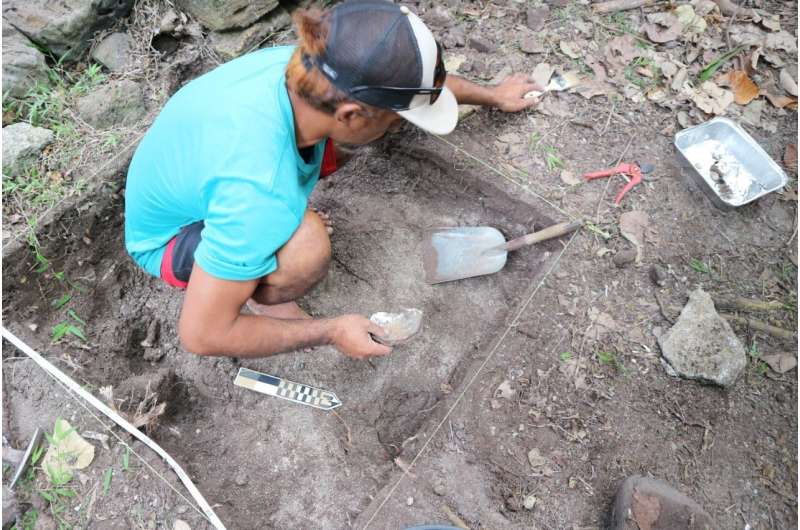This article has been reviewed according to Science X's editorial process and policies. Editors have highlighted the following attributes while ensuring the content's credibility:
fact-checked
trusted source
proofread
Mysterious pearl shells unearthed in French Polynesia

What was everyday life like for French Polynesians in the 19th century? An archaeology team co-led by the University of Sydney's Associate Professor James Flexner sought to find out during fieldwork in the Îles Gambier (Mangareva Islands) in French Polynesia, in October and November 2023.
With close collaboration from local cultural association Te Ana Pouga Magareva, the team focused their efforts on sites on the islands of Aukena and Akamaru. These included priests' houses attached to the oldest church in the country, St. Raphaël (constructed in 1837), as well as at a boys' school and at another priest's house on the island of Akamaru. They found over 1,500 objects in 19 test pits excavated at six different sites.
Most were associated with everyday life: ceramic plates and bowls, bottles containing perfume, medicine, and alcohol, and fragments of past meals including fish and bird bones and shellfish.
Fieldwork, finds, and community
The richest trove of finds came from the priests' house at the Church of Notre Dame de la Païx at Akamaru. Hundreds of fragments of glass were recovered at the site, equating to dozens of bottles of gin, champagne and wine, as well as perfume and medicine imported from France, Britain, and the Netherlands.
Another distinctive find was hundreds of complete and fragmented pearl shells (from the Pinctada genus), which were cultivated to be worked into objects like buttons and decorative inlay, offering a glimpse into the island's former pearl shell industry.
But not all the finds were so quotidian. "Sometimes you find individual things that tell an amazing and immediate story," said Flexner, from the School of Humanities. In this case, he is referring to a 1cm bronze crucifix, found at a boys' school at Aukena. "This would have been something very personal—the boy would have worn it every day on his body," Flexner observed.
The most intriguing find, however, was retrieved from a trench at the boys' school. Below an iron axe head, placed in a hole, were three complete pearl shells.
Traditionally, in French Polynesia, pearl shells were used for fishing lures, tattooing needles, pendants and figurines. By the 1840s, they were harvested en masse and exported around the world. The missionary endeavor in Mangareva was supported by Polynesian people cultivating and preparing thousands of tons of the valuable shells.
Associate Professor Flexner thinks the buried mollusks are evidence of work experience—they were used by the missionaries to train local boys in how to grow the animal, harvest it, and then process the shell for export.
The team is planning two additional seasons of excavation in the islands of Mangareva, Akamaru, and Aukena next year. Having shown the potential for rich finds in these sites, they are looking forward to seeing what else lies buried beneath the mission buildings. Simultaneously, they are facilitating digital repatriation of documents pertaining to Mangareva from the Royal Geographical Society in London.
"Ultimately, the project is a partnership with individuals and groups in the Mangarevan islands," Flexner said. "It's about helping the community understand its own past to inform its present."
Provided by University of Sydney



















